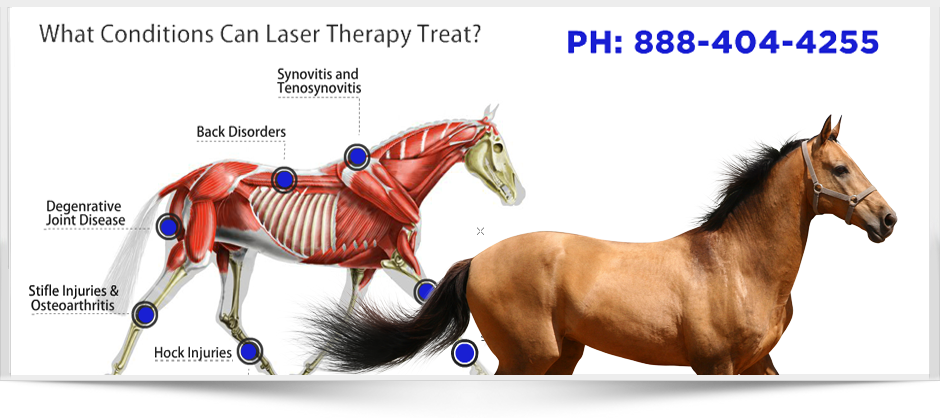Laser Treatment in Horse Treatment: A Modern Approach to Improving Steed Wellness
Laser treatment has become an essential technique in equine therapy, using focused light power to foster mobile repair service and speed up recovery from a variety of disorders. This non-invasive method is particularly reliable in handling bone and joint injuries, wounds, and inflammatory problems, considerably boosting overall steed health. By boosting mitochondrial activity and improving ATP production, laser therapy not just improves flow but likewise gives considerable discomfort alleviation. As this ingenious therapy continues to acquire grip, it opens appealing opportunities for dealing with persistent problems like arthritis and hoof troubles, signaling a transformative shift in vet treatment. What makes this modality especially engaging?
Understanding Laser Therapy
Laser therapy, a non-invasive therapy technique, has actually obtained substantial grip in equine medication due to its efficacy in promoting healing and pain relief. This advanced therapeutic method uses focused light energy to penetrate tissues, fostering cellular repair work and regeneration. The underlying system includes the stimulation of cellular mitochondria, resulting in enhanced production of adenosine triphosphate (ATP), the power money of cells. Boosted ATP degrees speed up tissue repair work processes and reduce swelling, making laser treatment specifically efficient for dealing with musculoskeletal injuries, wounds, and various other inflammatory problems in equines.
There are numerous sorts of lasers used in equine treatment, each with particular wavelengths and power outputs customized to different healing requirements. Low-level laser treatment (LLLT), likewise known as cool laser therapy, uses lower power degrees to promote cell feature without triggering thermal damages. High-intensity laser therapy (HANDLE), on the other hand, makes use of higher power degrees to achieve much deeper tissue infiltration and even more considerable healing impacts.
Veterinarians make use of different laser tools and techniques relying on the condition being dealt with and the desired depth of cells penetration. Appropriate training and know-how are important for ensuring the risk-free and reliable application of laser therapy, consequently optimizing its therapeutic capacity while decreasing risks.
Advantages for Horse Wellness
With a solid understanding of exactly how laser therapy works, it is important to explore its countless advantages for equine wellness. By boosting mobile function, laser therapy advertises faster injury recovery and help in the regrowth of damaged tissues.
Furthermore, laser therapy has been shown to improve flow, consequently enhancing blood flow to affected areas. Enhanced circulation ensures that important nutrients and oxygen are provided much more efficiently, assisting in the healing process. In addition, laser treatment's anti-inflammatory results aid in minimizing swelling and pain, which is critical for the total well-being of the steed.
Discomfort administration is an additional significant advantage. By launching endorphins and obstructing pain signals, laser therapy gives reliable, non-invasive alleviation from both intense and chronic pain. This can add to boosted flexibility and lifestyle for the animal.
Last but not least, laser therapy is a non-invasive therapy option, decreasing the danger of complications related to more invasive treatments. Its flexibility and efficiency make it a vital tool in contemporary horse veterinary medicine.
Usual Conditions Dealt With

One more common condition treated with laser therapy is joint inflammation. In addition, laser treatment is utilized in the administration of wounds.
Equine respiratory system problems, such as recurring respiratory tract obstruction (RAO), likewise respond favorably to laser treatment. The anti-inflammatory properties of the therapy help in decreasing airway swelling, therefore enhancing respiratory feature. Laser treatment is useful in treating unguis issues, consisting of laminitis and abscesses. By improving circulation and reducing discomfort, it supports quicker recuperation.
Treatment and Safety
Carrying out laser therapy in equine therapy involves a careful procedure to make sure both efficacy and security. Equine Therapy. The process begins with a comprehensive vet analysis to figure out the suitability of laser therapy for the steed's certain problem. Once regarded appropriate, the treatment location is prepared by cleaning and, if required, clipping the hair to boost laser penetration
The professional has to select the right sort of laser, usually a low-level laser (LLLT) or a high-power laser (HPL), relying on the condition being treated. The laser gadget is after that adjusted to the suitable wavelength, power, and duration setups. Throughout the application, the practitioner moves the laser over the targeted area in an organized fashion, ensuring constant and even Read Full Article direct exposure.
Safety and security protocols are strictly stuck to, including using safety glasses for both the expert and the horse. Additionally, it is vital to check the steed for any signs of discomfort or adverse reactions throughout the procedure. Post-treatment, the horse is typically provided a period of rest to enable the restorative impacts to materialize.

Future of Horse Laser Therapy
As improvements in veterinary medication continue to unravel, the future of equine laser therapy holds substantial guarantee. Arising innovations and much deeper scientific understandings are set to improve and broaden the applications of laser treatment for horses.
In addition, continuous study into the molecular and mobile mechanisms of laser treatment will likely generate enhanced methods tailored to certain conditions, enhancing performance and decreasing therapy times. Personalized treatment plans based upon hereditary and biochemical markers might come true, making sure that each horse gets one of the most appropriate and effective treatment.
In addition, regulatory improvements and standardization of protocols will certainly enhance the reputation and reliability of laser therapy in equine method. Equine official site Therapy. As these technologies remain to emerge, equine laser treatment is positioned to come to be an essential part of vet treatment, offering boosted healing and improved high quality of life for steeds globally
Conclusion
